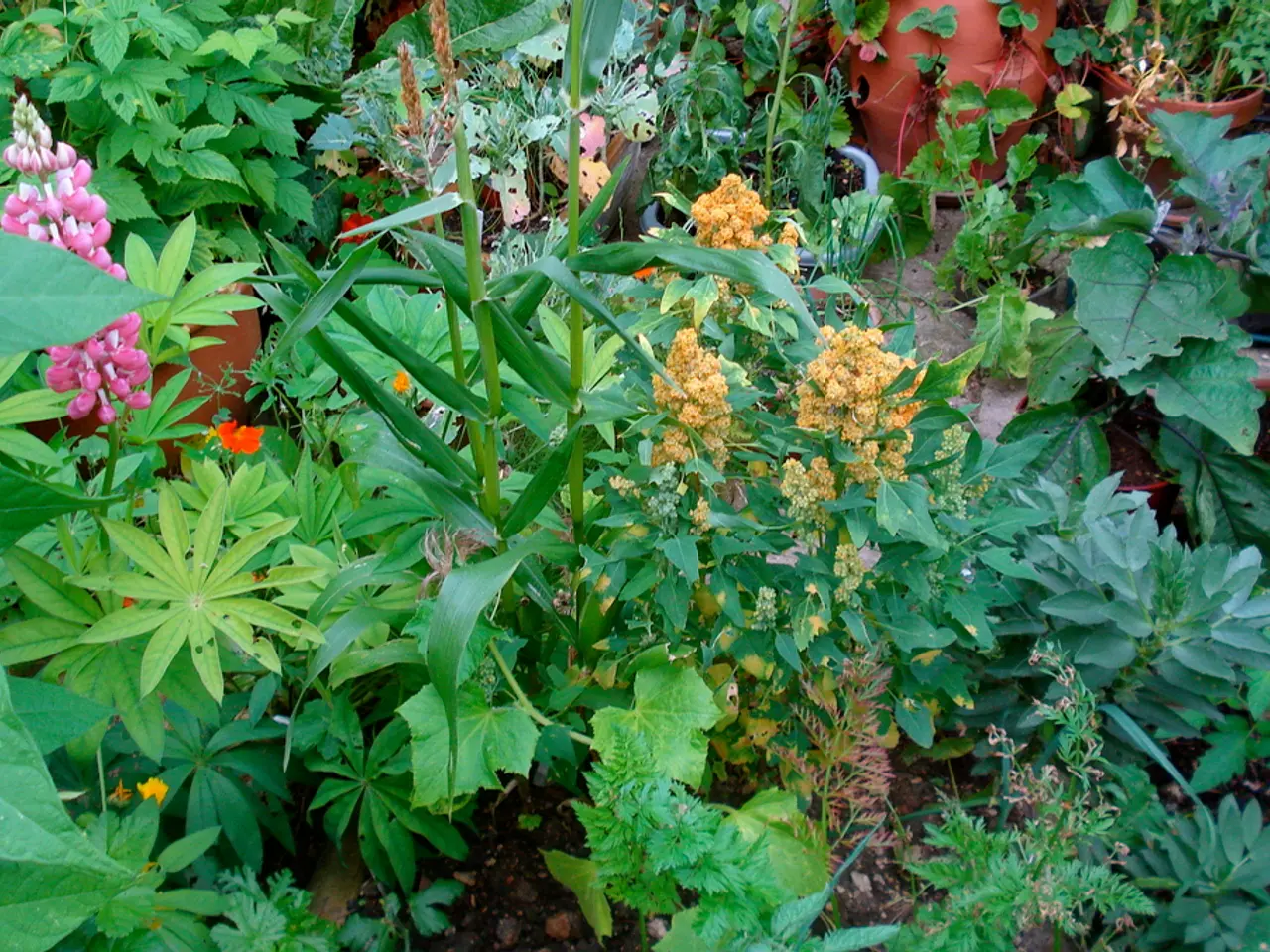Strategies for Minimizing Upkeep in a Drought-Resistant Landscape Design
In the quest for a beautiful and eco-friendly garden, xeriscaping has emerged as a popular choice. This innovative approach to landscaping not only saves water but also supports local wildlife and promotes a sustainable lifestyle. Here's a comprehensive guide to implementing xeriscaping in your own garden.
Xeriscaping involves the strategic use of native plants, efficient irrigation systems, and smart planning to create a low-maintenance, water-efficient garden. Beyond native plants and drip irrigation, additional eco-friendly practices include soil improvement, mulching, turf management, smart planning and design, incorporating hardscape elements, ongoing maintenance, recycling and reusing materials, and more.
Soil improvement involves enriching the soil with organic amendments such as compost, worm castings, and biochar. This helps retain moisture, making water more accessible to plant roots in dry conditions. Mulching, another crucial practice, reduces soil evaporation and suppresses weeds, conserving soil moisture and reducing water demand.
Minimising lawn areas or using low-water grass varieties lowers water consumption since traditional turfgrass typically requires more irrigation. Smart planning and design ensure the garden layout is based on the yard’s specific sun exposure, shade, and drainage patterns, ensuring plants are placed in optimal conditions that reduce water stress.
Incorporating hardscape elements such as gravel, boulders, stone pathways, and river bed designs can reduce planted areas and water needs while adding aesthetic and functional value to the garden. Regularly monitoring plant health, pruning, and adjusting irrigation schedules as the landscape matures helps maintain water efficiency and plant vigor.
Sustainable landscaping companies may recycle excess materials or donate them, reducing waste associated with garden installation or renovation. Watering plants early in the morning or late in the evening reduces evaporation, and collecting rainwater in a rain barrel provides free water for plants.
Transforming a yard into a low-maintenance xeriscape oasis saves time and water. Xeriscaping is cost-effective due to lower water bills and reduced garden supply costs. The method for creating a beautiful, low-maintenance garden that saves water is known as xeriscape gardening.
When choosing plants, consider climate compatibility, soil type, sunlight needs, and growth rate. Layering shrubs in front of trees provides extra shade and coverage. Suitable low-maintenance plants for xeriscaping include sedum, lavender, agave, Russian sage, yarrow, and succulents.
Using drip irrigation delivers water directly to the roots, saving water compared to traditional sprinklers. Xeriscaping requires less work, including less time spent weeding and watering. Good soil quality, achieved through testing and amending based on test results, helps retain moisture and is important in a water-efficient garden.
Dividing a garden into zones based on plant water needs can help with effective watering. Using a windbreak (fence or dense plants) shields the garden from strong winds. Water conservation is a key benefit of xeriscaping.
Incorporating organic matter into the soil enriches it and improves its ability to retain moisture. Choosing native plants that are adapted to local climate and soil conditions makes them more resilient. Mulching helps retain moisture and reduce weeds.
Using drought-tolerant materials like flagstone and concrete pavers in landscaping reduces maintenance. Xeriscaping focuses on using native plants that thrive in the local climate. Grouping plants with similar water needs together for more efficient watering. Leveling the ground prevents water pooling in one area. Using rock mulch reduces weeds and retains moisture.
In summary, xeriscaping is a sustainable, water-efficient approach to landscaping that offers numerous benefits. By implementing these practices, you can create a beautiful, low-maintenance garden that conserves resources, supports plant health, and creates a resilient xeriscape garden.
- The quality of the soil in a xeriscape garden can be improved with organic amendments like compost, worm castings, and biochar.
- Xeriscaping also includes the smart use of drip irrigation systems for efficient watering.
- In the realm of workplace-wellness, xeriscaping can be seen as a form of medical-condition management due to its potential to alleviate chronic diseases related to environmental factors.
- The fight against cancer and respiratory conditions may indirectly benefit from xeriscaping, as gardens can provide spaces for physical activity, contributing to overall health and wellness.
- Digestive health can also be fostered by spending time in a xeriscape garden, as the fresh air and stress-reducing environment promote a healthy gut.
- For those concerned about eye-health, the exposure to natural light in a garden, as part of a balanced routine, can contribute to eye health and well-being.
- The hearing impaired can find peace in a xeriscape garden, as the reduced noise from traditional lawns creates a more tranquil environment.
- Health and wellness, in general, can be significantly improved by incorporating elements of fitness and exercise into a xeriscape garden, such as a designated area for yoga or a walking path.
- Autoimmune disorders might find relief in the reduced chemical exposure and stress levels associated with a chemical-free, low-maintenance xeriscape garden.
- Climate change can be combated through the implementation of xeriscaping in the manufacturing industry, as it requires less water and reduces energy consumption for irrigation.
- Skin-care benefits can result from spending time outside in a xeriscape garden, as the fresh air and natural light can contribute to clearer, healthier skin.
- Therapies and treatments may find increased effectiveness in a xeriscape garden setting, as the peaceful, nature-focused environment can aid in relaxation and stress reduction.
- Nutrition plays a crucial role in maintaining weight-management, and a xeriscape garden can provide a space for cultivating fruits and vegetables for a balanced diet.
- Xeriscaping can contribute to cardiovascular health through regular outdoor activity like gardening or exercise.
- The industry of xeriscaping is booming, with many companies offering environmentally-friendly solutions for sustainable landscaping.
- Medicare and other health insurance policies may cover some of the costs associated with xeriscaping for individuals with medical conditions that benefit from the practice.
- CBD oil, derived from the hemp plant, can be used in skin-care products for a variety of skin conditions that may arise in a xeriscape garden.
- Neurological disorders may find some relief in the serene, nature-focused environment of a xeriscape garden.
- Environmental science plays a crucial role in xeriscaping, as understanding the local climate and soil conditions is essential for proper plant selection and implementation.
- Financing sustainable projects, such as xeriscaping, can be made easier through investments in the finance, energy, and fintech sectors.
- Xeriscaping can contribute to healthy relationships, as time spent gardening together can strengthen bonds and build a sense of community.
- The well-being of pets can be supported by creating a pet-friendly xeriscape garden, complete with safe plants and shaded areas for relaxation.





